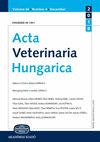Prevalence, characterization and antimicrobial resistance of non-O157 Shiga toxin-producing Escherichia coli isolates from healthy cattle in Tunisia
IF 0.8
4区 农林科学
Q3 VETERINARY SCIENCES
引用次数: 0
Abstract
Abstract As a continuation of our previous work, here we examined the occurrence, virulence factors and antibiotic resistance of non-O157 Shiga toxin-producing Escherichia coli (STEC) bacteria in faecal samples of healthy cattle in Tunisia. From 260 faecal samples, 236 E. coli isolates were obtained, of which 30 (12.7%) proved to be non-O157:H7 STEC. The presence of STEC-serogroup virulence genes stx1, stx2 , eaeA and ehxA was detected by PCR. Further virulence genes and other genes used for phylogenetic grouping were also examined among the STEC isolates. The most dominant serogroup was O145, followed by O103 and O45. Shiga toxin gene ( stx1 ) was found in 70% of the STEC strains, stx2 and ehxA were detected in 17 isolates (56.7%). Other virulence genes, including fimH , traT, sfa/focDE , iutA , cdt3 , hly, fyuA and ibeA, were detected in 100%, 60%, 46.7%, 46.7%, 36.7%, 10%, 6.7% and 3.3%, of the strains, respectively. More than 70% of the isolates were susceptible to most of the tested antibiotics. We concluded that the presence of STEC O145, O103 and O45 (12.7%), together with the earlier described STEC O157:H7 (4.2%) in cattle, intended for slaughter, may represent a threat to public health. Efficient control measures are needed in the farms and slaughterhouses in Tunisia.突尼斯健康牛中非o157产志贺毒素大肠杆菌的流行、特征和耐药性
作为我们之前工作的延续,在这里,我们检测了突尼斯健康牛粪便样本中非o157产志贺毒素大肠杆菌(STEC)细菌的发生、毒力因素和抗生素耐药性。从260份粪便样本中分离出236株大肠杆菌,其中30株(12.7%)为非o157:H7产志贺毒素大肠杆菌。PCR检测stc血清组毒力基因stx1、stx2、eaeA和ehxA的存在。进一步的毒力基因和用于系统发育分组的其他基因也在产志贺毒素大肠杆菌分离株中进行了检测。血清型以O145为主,其次为O103和O45。志贺毒素基因(stx1)在70%的产志贺毒素菌株中检出,stx2和ehxA在17株(56.7%)中检出。其他毒力基因分别为fimH、traT、sfa/focDE、iutA、cdt3、hly、fyuA和ibeA,分别为100%、60%、46.7%、46.7%、36.7%、10%、6.7%和3.3%。超过70%的分离株对大多数测试抗生素敏感。我们的结论是,产STEC O145、O103和O45(12.7%)以及之前描述的产STEC O157:H7(4.2%)存在于屠宰牛中,可能对公众健康构成威胁。突尼斯的农场和屠宰场需要采取有效的控制措施。
本文章由计算机程序翻译,如有差异,请以英文原文为准。
求助全文
约1分钟内获得全文
求助全文
来源期刊

Acta veterinaria Hungarica
农林科学-兽医学
CiteScore
1.80
自引率
0.00%
发文量
39
审稿时长
>36 weeks
期刊介绍:
Acta Veterinaria Hungarica publishes original research papers presenting new scientific results of international interest, and to a limited extent also review articles and clinical case reports, on veterinary physiology (physiological chemistry and metabolism), veterinary microbiology (bacteriology, virology, immunology, molecular biology), on the infectious diseases of domestic animals, on veterinary parasitology, pathology, clinical veterinary science and reproduction.
 求助内容:
求助内容: 应助结果提醒方式:
应助结果提醒方式:


